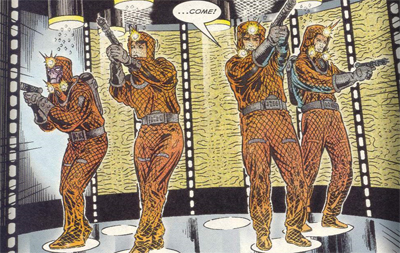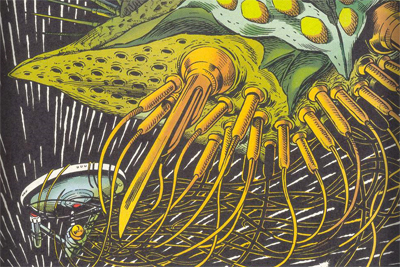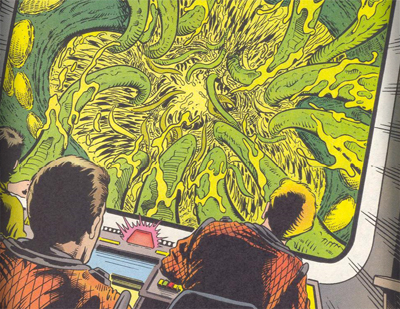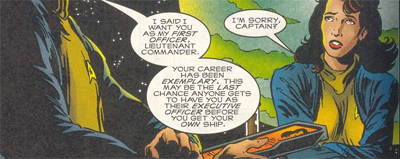To celebrate the release of Star Trek: Into Darkness this month, we’ll be running through the first season of the classic Star Trek all this month. Check back daily to get ready to boldly go. It’s only logical.
We’ll be supplementing our coverage of the episodes with some additional materials – mainly novels and comics and films. This is one such entry.
In the late nineties, Marvel were publishing Star Trek comic books. One of those books, perhaps the book garnering the most critical praise, was Star Trek: Early Voyages. Written by Dan Abnett and Ian Edginton, the series was intended to follow the mission of the USS Enterprise under the command of Captain Christopher Pike. Published monthly, the comic is perhaps the best indication of what a Star Trek show starring Christopher Pike might have actually looked like. Although the series was cancelled suddenly after only seventeen issues, ending on a cliffhanger, it is still a fascinating look at what might have been.
Abnett and Edginton write Early Voyages very well. The duo take care to write the comic in a very sixties style, consciously channelling a version of the future as it would have been imagined at the time when the original show went to air. So we get a version of Christopher Pike who still seems a little uncomfortable with the idea of a woman on his bridge, an attitude that would seem a little unfortunate in the late nineties, let alone a few centuries in the future.
“In my absence, you are my trusted right-hand man… uh… woman!” he tells her, awkwardly. It’s quite similar to some of the cringe-inducing lines that the original Star Trek would give Kirk from time to time, in episodes like Charlie X. Abnett and Edginton wisely steer clear of any of the actual sexism quite evident in the classic show. In particular, there’s no indication that Number One has a massive crush on Pike because he’s such a dashing macho figure. However, little touches like giving Pike that sort of awkward hesitation feels like an acknowledgement that Abnett and Edginton are telling a story that is intended as a hold-over from the sixties.
And Flesh of my Flesh definitely feels like it was written while channelling the pulpy science-fiction vibe of the mid- to late-sixties. In particular, the duo construct the first Early Voyages story in such a way that it invites comparison with Pike’s only filmed story, The Cage. Both stories are pilots that begin with the ship’s mission long under way, only to take a journey into Pike’s mind to provide some context for events. In The Cage, the Talosians planned to use his memories and imagination to compel him to breed a race of slaves. Here, the Ngultor plan to harness his memories to provide them with information about a new food source.
Much like the idea of the Talosians breeding a race of slaves felt like a plot device from a trashy B-movie, the Ngultor’s sinister plan to eat humanity feels like a relic from some pulpy science-fiction film. “Maybe we’re too big to swallow whole and are being taken to some kind of larder,” Number One declares at one point. Sadly, the Enterprise never directly asks the aliens to take them to their “larder.”
Even the structure of Flesh of my Flesh seems designed to evoke memories of The Cage. Pike is kidnapped, kept captive, and forced to journey inside his own mind. In the meantime, his crew try to figure out how to get him back, with Spock organising a helpful scientific briefing to explain to the crew (and the audience or readers) what exactly is going on. This decision to structure Flesh of my Flesh as a direct call-back to The Cage creates a sense of continuity, even where televised Star Trek had already leapt forward in time by a century, and Star Trek: The Next Generation was long over.
The Ngultor themselves feel like a decidedly retro bad guy. There is an obvious overlap between this species and the Borg, for example, but – had they appeared on sixties television – they would also work quite well as a Cold War metaphor for communism. Flesh of my Flesh would sit comfortably alongside other Cold War adventures like Return of the Archons or The Apple. The Ngultor are one gigantic collective organism, where everything is shared, even self.
The individual is literally digested into the whole. Memory and thought are absorbed and consumed. They are the antithesis of the individual. “It is entirely organic,” Spock observes. “It may even be a single organism.” Later on, Spock clarifies that the ship attacking the Enterprise could alternatively be one giant organism or multiple smaller organisms, or some combination of the two – it is impossible to distinguish the individual from the whole. “Captain, it is a life form – however, I am also detecting multiple life signs within it — perhaps parasites or young?”
“Why do you resist the rapture of the flesh… the sacred harmony of blood… bone and gristle?” they ask Pike at the story’s climax. “Your action-motives are incomprehensible to us.” It seems like the same sort of difficulty that both sides had during the Cold War, where it seemed impossible for either side to understand the other. They ask Pike to join “a single union of wholeness” – the use of the word “union” seeming rather pointed. Given that the Federation is typically treated as a stand-in for America in those early Star Trek stories, that would make the Ngultor the communists.
Of course, it’s entirely possible that the metaphor is intended to apply as much to the nineties. Flesh of my Flesh was obviously written in the period after the Cold War. Perhaps the Ngultor aren’t intended as an affectionate throwback to Cold War paranoia in an era where that ideological conflict feels so long ago. Perhaps they are intended as a metaphor about the difficulties reconciling the need for personal autonomy with obligations to wider society, the sort of individualist existential crisis that prompted much soul-searching during the nineties. Without an enemy to define America, what was it?
After all, as mentioned above, there is some conceptual similarity between the Borg and Ngultor, and the Borg were created as a threat towards the end of the second season of Star Trek: The Next Generation, long after the height of the Cold War, as the conflict was slowly grinding to an end. It’s possible that Ngultor aren’t intended as a throwback to the sort of foes and Lovecraftian horrors that hounded Kirk’s Enterprise, but they feel more closely related to the giant space amoeba from The Immunity Syndrome or the vampire cloud from Obsession than the pregnant space whale from Galaxy’s Child or Species 8472 from Scorpion.
It’s clear that Abnett and Edginton are massive Star Trek fans. Using the Ngultor as a plot mechanism, the duo show us Captain April handing over the Enterprise to Christopher Pike. This was at a time when the canonicity of Star Trek: The Animated Series was up for debate. Roddenberry had explicitly removed it from canon at the end of the first season of The Next Generation, but references had begun to creep back in following his death. Similarly, the duo work in the popular piece of fan canon that Spock is “the first Vulcan to join Starfleet”, even if there’s actually nothing on the television show to support that popular assumption.
The pair also write a convincing version of Christopher Pike, at least a version who corresponds to the character portrayed by Jeffrey Hunter in The Cage. As played by Hunter, Pike seemed a more introspective and more buttoned-down commanding officer than James Tiberius Kirk. As such, one might expect that stories featuring pike would play out slightly differently, and that he would respond to these problems in his own way.
Here, for example, the first question Pike asks after reviewing the dossiers of his senior staff speaks volumes of his character. “Will they listen to me? Take orders when the chips are down?” There’s a hint of insecurity there, but also a very clear preference for order rather than innovation. It’s hard to imaging Pike getting along too well with Scotty’s tendency for improvisation, for example.
Abnett and Edginton also suggest that Pike would forgo the kind of ending one associates with Kirk. Episodes of the classic Star Trek would frequently end with Kirk, Spock and McCoy sharing a light-hearted joke about what just happened. Pike is nowhere near that casual. In fact, he’s downright melancholy. “We made it, Number One, but it’s such a hallow victory,” he observes after the Enterprise saves the day. “We met a new race and the only common language we had was violence.” When Number One rightly points out that Ngultor would have killed and eaten them, Pike still puts a downer on it. “I know, but it still doesn’t feel right somehow.”
It is very clear that Abnett and Edginton have put a lot of thought into this. They aren’t just writing a generic Star Trek comic and using a few names from that very first episode. Instead, they seem to have crafted a story that calls back to the era from whence these characters emerged, and to have taken a look at what the structure of a series based around these characters might have looked. They realise that Pike isn’t Kirk, so it wouldn’t look or behave exactly like a classic Star Trek episode, despite the familiar trappings and plot elements.
Published monthly for over a year, Early Voyages remains the only real evidence we have of what a series starring Pike might look like. Of course, authors have written books starring the character, and there’s the odd allusion to his importance in various other novels, but Early Voyages is a series based around the character. As such, it’s a fascinating read. It’s clear that Abnett and Edginton have a very deep fondness for Star Trek, and it shines through, making it a tragedy that the comic only lasted seventeen issues.
You might be interested in our other reviews from the first season of the classic Star Trek:
- The Cage
- Supplemental: Vulcan’s Glory by D.C. Fontana
- Supplemental: Early Voyages #1 – Flesh of my Flesh
- Supplemental: Crew by John Byrne
- Where No Man Has Gone Before
- The Corbomite Manoeuvre
- Mudd’s Women
- The Enemy Within
- The Man Trap
- The Naked Time
- Charlie X
- Balance of Terror
- Supplemental: My Enemy, My Ally by Diane Duane
- Supplemental: Romulans: Pawns of War by John Byrne
- What Are Little Girls Made Of?
- Supplemental: Errand of Vengeance: The Edge of the Sword by Kevin Ryan
- Dagger of the Mind
- Miri
- The Conscience of a King
- The Galileo Seven
- Court Martial
- The Menagerie, Part I
- Supplemental: Early Voyages #12-15 – Futures
- The Menagerie, Part II
- Supplemental: Burning Dreams by Margaret Wander Bonanno
- Shore Leave
- The Squire of Gothos
- Arena
- Supplemental: Requiem by Michael Jan Friedman & Kevin Ryan
- The Alternative Factor
- Tomorrow is Yesterday
- The Return of the Archon
- A Taste of Armageddon
- Space Seed
- This Side of Paradise
- The Devil in the Dark
- Errand of Mercy
- Supplemental: Spock Must Die! by James Blish
- Supplemental: The Final Reflection by John M. Ford
- The City on the Edge of Forever
- Supplemental: The City on the Edge of Forever by Harlan Ellison/Cordwainer Bird
- Supplemental: Crucible: McCoy – Provenance of Shadows by David R. George III
- Supplemental: Star Trek (Gold Key) #56 – No Time Like the Past
- Operation — Annihilate!
Filed under: Comics, The Original Series | Tagged: borg, Christopher Pike, Cold War, dan abnett, deep space nine, Hulu, J. J. Abrams, Pike, spock, Star Trek Into Darkness, Star Trek Next Generation, star trek: enterprise, Star Trek: The Animated Series, star trek: the next generation, StarTrek, USS Enterprise, William Shatner |




























Marvel got a lot right with their post-First Contact Trek comics.
I really dug the Early Voyages comics (yep, there are more reviews coming!). I’m tempted to try Starfleet Academy. Worth a go?
My favorite series from that period is the one that’s set between the first movie and Wrath of Khan. And Starfleet Academy is my next favorite. It comes highly recommended for Trek geeks.
I got the GIT digital archive, so I’ll have to dig that out, if it’s on there? Is this the one that launched with an X-Men crossover?
I’m not sure what’s on the GIT archive. I got the hard copies back in the day.
And I think the X-Men crossover was entirely contained in three pieces: X-Men/TOS, X-Men/TNG, and a sequel novel featuring X-Men and TNG again. The TOS crossover sort launched all the Star Trek series that Marvel did in the late 90s by featuring extensive previews of each at the back of the book. But none of the comic series built on these stories in any way that I can remember.